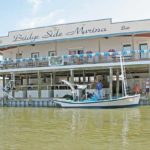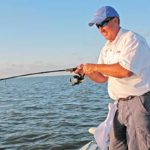
Fish these six spots, and you’ll be filling your cooler with tasty Grand Isle summer specks.
Grand Isle is a seven-square-mile barrier island connected to the rest of Louisiana by a narrow causeway. Located about 100 miles from New Orleans, the narrow island separates Barataria Bay from the Gulf of Mexico, and is the permanent home of 1,500 residents.
Drive through it during much of the year and you’d think it was a quaint and picturesque fishing village. But such appearances can be deceptive, because in the summer, everything changes.
People who love to fish come in from all over, many towing boats behind them, to indulge in what has to be some of the very best fishing found anywhere in the country. If that sounds like an exaggeration, it isn’t. The population during the summer months swells to upwards of 20,000, and all of them want to catch fish.
Offshore boats will target red snapper, mangroves, amberjack and grouper at the rigs, and dolphin, tuna, marlin, tripletail and wahoo on the rip lines. A short run by boat from Grand Isle can put you into some serious deep-sea action.
Personally, whenever the calendar gets around to July and August, I automatically think of speckled trout, and nowhere are they more easily accessible right now than Grand Isle.
I had a trip all lined up to get in on some of the great action with Capt. Keith “Herk” Bergeron (985-860-7855) and Buggy Vegas from Bridgeside Marina (985-787-2419), but horrendous winds caused us to cancel. We rescheduled on a day that looked “iffy” at best, but Herk was willing to give it a try despite another windy forecast.
We tossed my gear aboard Herk’s bay boat, and once we persuaded Buggy to quit working and climb in, we took off.
Daylight was barely peeping over the horizon as we made our way out to some structure Herk had been fishing successfully before all the winds kicked up, with the hope the trout would still be there. He anchored to position the boat so we’d have the wind to our backs as we tossed toward the structure.
We had two baitwells loaded up with live croakers, and the plan was to hook them under a sliding ¼-ounce sinker and see if we could entice a bite. But we first wanted to toss some topwater baits while it was still early enough to do so.
Herk and I both threw Top Dog Jrs., while Buggy tossed a Carolina-rigged live croaker, saying he’d have to catch all the fish if we were going to play around. We made several casts without success, while Buggy got almost instant hits on the live croakers. Herk caught a nice trout on the topwater, and I had a few swipes at mine, but Buggy was on fire.
The trout were eating up those croakers, and Herk and I changed rods to join in the fun.
“This is the way it is out here from now until the end of summer,” Herk said. “The trout action has been nothing short of spectacular all around the island. We are catching some very nice-sized fish right now, and in very good numbers. It’ll be great in July and August.”
Herk says the trout are so thick that even novices to the island are catching more fish than they’ve ever caught before.
“With a baitwell full of live shrimp and croakers, and just a little nudge in the right direction, anybody with a boat can catch trout like an expert right now,” he said.
Herk’s half-dozen hints
If you want to catch trout in Grand Isle this summer, here’s where to go and what to do:
1. The beaches at Elmer’s Island.
“This is a fantastic place to fish in July, and you can fish it one of two ways: anchor, and toss either live croakers Carolina-rigged or live shrimp about 18 inches under a popping cork,” Herk said.
The key is to run along the shoreline and look for birds diving over shrimp or signs of shrimp jumping out of the water.
“When you see that, you know there’s trout under them. Anchor and fish there,” he said.
The other method is to fish one of the three big run-outs along the beach.
“There are three distinctive run-outs along Elmer’s,” Herk said. “When you come out of Caminada Pass, the first run-out is along the shore about ¾ mile from the pass. The second one is about two miles from the pass, and the third one is about a mile past the second one.
“Bait gangs up in those run-outs, and fish swarm in there after them, so you want to anchor so you can toss to the run-outs.”
When it comes to anchoring, Herk says to stay on the south side of the first sand bar, which will have you anchoring about 100 feet from the shore.
“Don’t let your boat get back into the breaking waves where it could be turned over,” he cautioned. “You want to anchor so you can cast to right where the waves are starting to break. Toss a live croaker Carolina-rigged or a live shrimp under a cork right there, especially on a falling tide, and you’ll catch some very nice trout.”
Herk says a south wind, a north wind or northwest wind are all great for beach fishing.
“Even an east wind is doable if it’s light or variable, but a hard east wind kicks up the seas and muddies up the water and makes the beach untenable,” he said.
2. The beach at Grand Terre.
Grand Terre is another barrier island, about three miles long, between Coup Abel and Barataria Pass. Herk says the water is a bit deeper around Grand Terre so you can anchor closer to the beach.
“Grand Terre has a very distinctive sand bar, and you can locate it easily with your depth sounder,” he said. “You’ll see the bottom stays about 7 feet deep pretty consistently, then it’ll rise up suddenly to 4 feet and then drop down again. That rise in the bottom is the sand bar, and that’s where you want to anchor your boat. Anchor so that you can cast right up to the beach in the surf.”
Herk says to use the same baits — live croakers Carolina-rigged or live shrimp under corks — or topwater baits if you fish early.
“You can do like you’d do at Elmer’s: Look for birds or shrimp jumping to determine where to anchor, or if you know where the run-outs are at Grand Terre, you can fish those. But you’ll only know where they are if you made a note of it during a very low tide,” he said. “The good thing about this island is it’s productive on any moving tide.”
3. The rocks by the state park.
“I like to freeline croakers along these rocks, using no weight at all,” he said. “The croakers will still try to hide up in the rocks, but you can usually pull them free and prevent a snag, but by freelining them you can toss your bait right up against the rocks.”
Herk says to fish the upcurrent side on a rising tide with live shrimp under a cork.
“You can also Carolina-rig a live croaker along there, but you can’t throw too close to the rocks or you’ll snag,” he said. “And you can fish a live croaker under a cork if you know how the cork will act with a croaker on it. It’ll wobble and bump and look all jittery like a fish is after it, but that’s just the croaker pulling it around. If a trout hits it, you’ll know.”
Herk says you can fish behind the rocks on an east wind and get out of the waves.
4. The reef north of Caminada Pass.
“Just north of Caminada Pass is a big reef well marked with white poles,” Herk said. “It’s a big reef, probably 500 yards or more in diameter. You’ll want to anchor anywhere over the reef, and toss live shrimp 3 or 4 feet under a cork. The bottom is too hard for a PowerPole or a push pole to stick, but you actually can Carolina rig over this reef without much fear of snagging the bottom.
“This area is protected on an east wind, so it’s a good option on those days when the surf is too rough to fish, but it is susceptible to a west wind, which tends to muddy everything up. Any moving tide makes this reef a good option.”
5. Hotel Sid and Bird Reef.
“The Hotel Sid structure has a lot of pilings all around it making it a great area to catch trout all summer long,” Herk said. “But it’s one of those places you want to fish early, because by 10 a.m., the bite is over.
“The best technique is to anchor upcurrent from the structure, and that way the boat will fall toward it and you can toss a live croaker Carolina-rigged right at the structure.
“The best-case scenario is when the wind and the current are working together, taking your bait toward the structure.”
Bird Reef (not to be confused with Bird Island) is just to the east of Hotel Sid, and it extends up about 2 feet off the bottom. Herk says it’s a good-sized reef, probably 700 to 800 yards long and about 200 yards wide.
“The reef has troughs in it, and if you can get a bait in those troughs, especially on an incoming tide, you’ll catch trout,” he said. “This is a great place to take kids fishing because it generates a lot of action, and it’s easy fishing. All you need is live shrimp fished about 3 to 4 feet under a popping cork.”
6. Middle Bank.
“Middle Bank is just a big wooden tower with a sign on it that says ‘Danger- Underwater Obstacle.’ The obstacle is the reef all around it, extending out 200 to 300 yards on all sides of the wooden tower,” Herk said. “The reef is not marked with white poles; it’s just a big flat-bottomed reef. Anchor anywhere over it, and cast live shrimp under a cork or shrimp or croakers Carolina-rigged.”
Meanwhile, the three of us were putting a whipping on some very nice trout. Herk and I tried tossing topwater baits again, but with limited success, while Buggy never wavered from his commitment to the live croakers.
Buggy definitely had the winning ticket. Those trout wanted live croakers, and virtually everyone we tossed resulted in a good hit. Trout No. 75 hit the box somewhere around 10 a.m., and we called it a day.
I call it a day to remember!
If catching speckled trout is on your itinerary this summer, there’s no better place than Grand Isle to do it.
Capt. Keith “Herk” Bergeron can be reached at (985) 860-7855.







